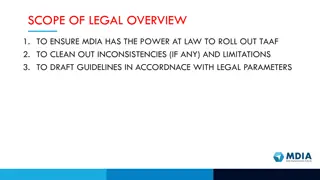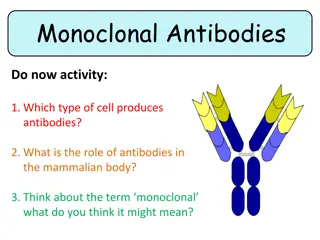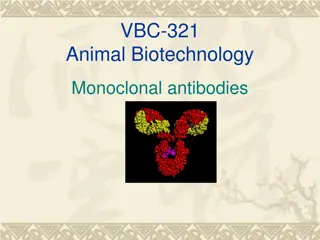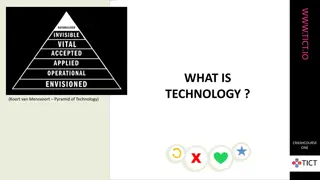
Hybridoma Technology: History, Steps, and Applications
Explore the history, steps, and applications of Hybridoma Technology, a method to produce monoclonal antibodies specific to antigens of interest. Learn about the formation of hybridoma cell lines, the discovery of this technology in 1975, and the technical procedures involved. Discover how Hybridoma Technology revolutionized biotechnology and antibody production.
Uploaded on | 1 Views
Download Presentation

Please find below an Image/Link to download the presentation.
The content on the website is provided AS IS for your information and personal use only. It may not be sold, licensed, or shared on other websites without obtaining consent from the author. If you encounter any issues during the download, it is possible that the publisher has removed the file from their server.
You are allowed to download the files provided on this website for personal or commercial use, subject to the condition that they are used lawfully. All files are the property of their respective owners.
The content on the website is provided AS IS for your information and personal use only. It may not be sold, licensed, or shared on other websites without obtaining consent from the author.
E N D
Presentation Transcript
StudyMafia.Org Hybridoma Technology Submitted To: Submitted By: Studymafia.org Studymafia.org
Table Contents Definition Introduction History of Hybridoma Technology Steps in Hybridoma Technology Applications of Hybridoma Technology Conclusion 2
Definition Hybridoma technology is a well-established method to produce monoclonal antibodies (mAbs) specific to antigens of interest. 3
Introduction Hybridoma cell lines are formed via fusion between a short-lived antibody-producing B cell and an immortal myeloma cell. Each hybridoma constitutively expresses a large amount of one specific mAb, and favored hybridoma cell lines can be cryopreserved for long-lasting mAb production. 4
History of Hybridoma Technology Hybridoma technology was discovered in 1975 by two scientists, Georges Kohler and Cesar Milstein. They wanted to create immortal hybrid cells by fusing normal B cells from immunized mice with their myeloma cells. For incidental reasons, they had all the requirements fulfilled and it worked in the first attempt. 6
History of Hybridoma Technology By cloning individual hybrid cells, they established the first hybridoma cell lines which can produce single type of antibody specific to the specific antigen. Their discovery is considered one of the greatest breakthroughs in the field of biotechnology. For the past decades, hybridomas have fueled the discovery and production of antibodies for a multitude of applications. 7
Steps in Hybridoma Technology Hybridoma technology is composed of several technical procedures, including antigen preparation, animal immunization, cell fusion, hybridoma screening and subcloning, as well as characterization and production of specific antibodies. 8
Steps in Hybridoma Technology Cell fusion Polyethylene glycol (PEG) and electrofusion are commonly used to induce cell fusion in hybridoma production. PEG fuses the plasma membranes of adjacent myeloma and/or antibody- secreting cells, forming a single cell with two or more nuclei. 9
Steps in Hybridoma Technology Hybridoma screening Even in the most efficient hybridoma fusions, only about 1% of the starting cells are fused, and only about 1 in 105 form viable hybrids. This leaves a large number of unfused cells still in culture. The cells from the immunized animal (antibody secreting cell) do not continue to grow in tissue culture and so do not confuse further work 10
Steps in Hybridoma Technology mAb production Hybridoma antibodies can be produced in vitro and in vivo. For production of monoclonal antibodies in vitro, hybridomas are expanded by transfer to 24 well tissue culture plates followed by 25 cm2 flask and a 75 cm2 flask containing suitable medium. 11
Applications of Hybridoma Technology mAb therapeutics Compared with other biologics, mAbs are able to maintain an extremely high affinity towards their target. Due to this high affinity and specificity, researchers began investigating the therapeutic potential of mAbs as metabolic activators, inhibitors and immuno- modulators. 12
Applications of Hybridoma Technology In vivo diagnostics In vivo diagnostics are a noninvasive way for clinicians to diagnose disease progression through analysis of biomarkers within the body rather than through biologic samples inside a laboratory. Most antibody-based in vivo diagnostics are used for highly specific imaging 13
Conclusion Hybridoma technology is one of the most common methods used to produce monoclonal antibodies. In this process, antibody-producing B lymphocytes are isolated from mice after immunizing the mice with specific antigen and are fused with immortal myeloma cell lines to form hybrid cells, called hybridoma cell lines. 14
References Google.com Wikipedia.org Studymafia.org Slidespanda.com
Thanks To StudyMafia.org






















